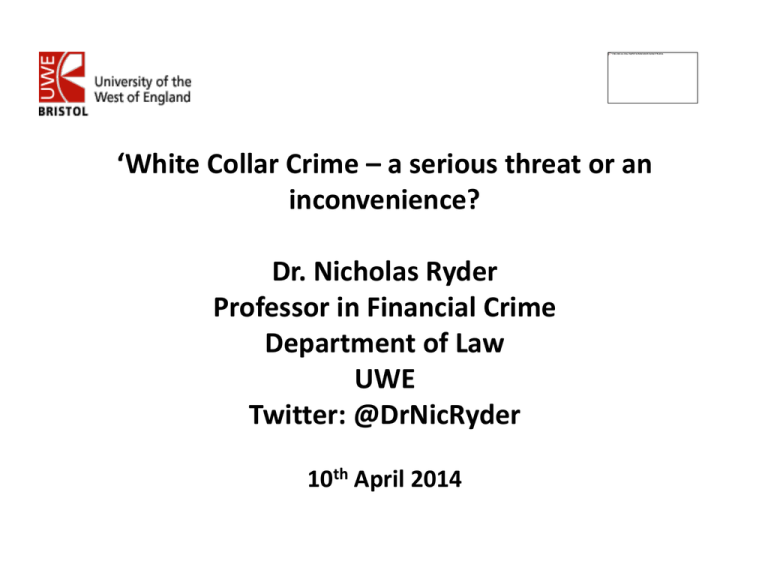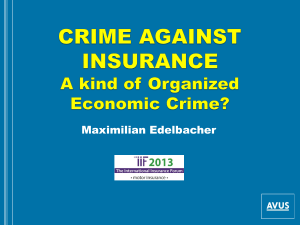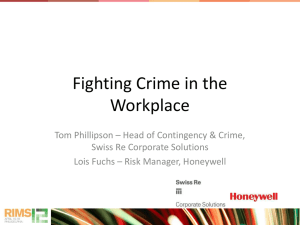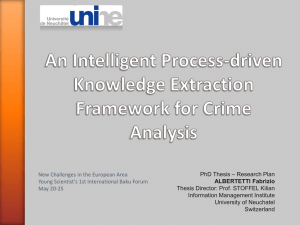Microsoft PowerPoint
advertisement

‘White Collar Crime – a serious threat or an inconvenience? Dr. Nicholas Ryder Professor in Financial Crime Department of Law UWE Twitter: @DrNicRyder 10th April 2014 Introduction • • • • • What is white collar crime? The extent of financial crime Money Laundering Fraud Final thoughts What is white collar crime? • The term was first used by Edwin Sutherland, who was described as the “most influential American criminologist of his day” • In his 1939 presidential lecture to the American Sociological Society he defined it as “a crime committed by a person of respectability and high social status in the course of his occupation”. What is white collar crime? • Sutherland stated that white-collar criminals include: – robber barons, – merchant princes, and – captains of finance and industry. • But is this definition still relevant in 2014? What is white collar crime? • “financial criminal will be defined as someone who has committed a financial crime and who has a certain level of standing (i.e. that of management) within a business or corporation” (Harrison and Ryder, 2013) What is white collar crime? • White collar crime has also been referred to as: – ‘financial crime’, – ‘economic crime’ and – ‘illicit finance’. • Examples of white collar crime include money laundering, insider dealing, fraud and market manipulation. The extent of Financial Crime • It is impossible to accurately quantify the true extent of financial crime which is taking place on a daily basis around the globe. • It is also due to the many methodological difficulties which are often encountered when trying to pull statistics together of this kind. The extent of Financial Crime • Fraud • National Fraud Authority (2011) – £39bn • National Fraud Authority (2012) – 73bn • National Fraud Authority (2013) – £52bn The extent of Financial Crime • Money Laundering – the FATF have extrapolated amount of the laundered profits could be in the region of 2 per cent of the global GDP. – IMF • $590 billion to $1.5 trillion – FATF • $500 billion The importance of Financial Crime regulation • ‘criminal proceeds have the power to corrupt and ultimately destabilise communities or [even] whole national economies’ (Financial Action Task Force, 2004). • The integrity of a nation’s financial institutions can be eroded by those organised criminals who seek to maximise their illegal profits so that they are able to enjoy, the so called champagne lifestyle (Ryder, 2011) • The effects of financial crime can ultimately threaten national security on the basis that terrorists need money and resources so that they can carry out their illegal activities (Ryder ,2011) The importance of Financial Crime regulation • Financial crime will almost certainly also have an adverse impact on the economies of countries. • The bomb attacks in London on the 7 and 21 July 2005 and the subsequent disruption to the transport system in London, cost the UK government in excess of £3 billion (Scanlan, 2006). Money Laundering • “With lightening speed, money can be wired from Yemen to terrorists in Florida for the destruction of buildings in New York and Washington. Business corruption, drug trafficking, arms smuggling and terrorism are sustained by the loopholes in the financial structure that allow illegal funds to slip through the system undetected” (Lacey and George, 2003) What is money laundering? – Processing of criminal proceeds to disguise their origin – – – – – Concealing Disguising Converting Transferring or removing Facilitates the acquisition – – – – – Retention Use or control Acquisition Use Possession • Above relate to proceeds of criminal activity The Scale of Money Laundering • International Monetary Fund – Between 2 and 5 % of Global GDP – $590 billion to $1.5 trillion – £20 to £50 billion (UK) • Financial Action Task Force – $500 billion How is money laundered? • Three recognisable stages: – Placement – Layering – Integration The Threat to Businesses • Criminal sanctions – Proceeds of Crime Act 2002 • Financial Penalties – Financial Conduct Authority – Credible Deterrence • Reputation – HSBC – Standard Chartered The Threat to Businesses • Anti-money laundering reporting obligations – – – – Know your client (KYC) Suspicious Activity Reports Proceeds of Crime Act (2002) Senior Management Arrangements, Systems and Controls (FCA Hand Book) – Failure to report could result in an unlimited fine and/or imprisonment – Increasing compliance costs – Defensive reporting Fraud • “The modern thief can steal more with a computer than with a gun” (Computer Science and Telecommunications Board, 1991) What is fraud? • “Persuading someone to part with something” (Doig, 2006) • “Deceit or an intention to deceive” (Omerod and Williams (2007) • “Act of deception intended for personal gain or to cause a loss to another party” (Serious Fraud Office, 2006) Some classic instances of fraud • Bank of Credit and Commerce International, • Barings Bank, • Enron • WorldCom • Bernard Madoff • Alan Stanford • Polly Peck (Azil Nadir), • Mirror Group Pension Scheme, • Guinness • Barlow Clowes Criminalisation of Fraud • The Fraud Act 2006 three possible ways of committing fraud: – false representation (s 2). – failing to disclose information to another person where there is a legal duty to disclose the information (s 3). – dishonestly abusing one's position (s 4). The Regulatory Agencies • There are several agencies that attempt to combat fraud: –Financial Conduct Authority –Serious Fraud Office –National Fraud Authority –The National Crime Agency • Economic Crime Command Anti-fraud reporting requirements. There is no general obligation to report fraud under the Fraud Act 2006 Senior Management Arrangements, Systems and Controls (FCA Hand Book) Action Fraud The Threat Posed by Fraud • Criminal sanctions – Fraud Act (2006) – Maximum custodial sentence of 10 years • Financial Penalties – Financial Services Authority – Unlimited – Applicable to employees and companies • Reputation The Threat Posed by Fraud • Cyber attack (National Security Strategy 2010) – “Cyber-crime has been estimated to cost as much as $1 trillion per year globally” – “Beijing experienced 12m cyber attacks per day during the 2008 games” • A joined up approach – Many companies are expected to act as financial policemen • Computer fraud Conclusions Fraud • Becoming the crime of choice for organised criminals and terrorists • Tougher sanctions • Cyber crime • Adverse impact on the economy • E-Fraud • Card fraud Money Laundering Too many vulnerable governments have not criminalised all forms of money laundering Too many governments place restrictions on AML measures International cooperation not sufficient The Internet Laws and regulations fail to keep pace









